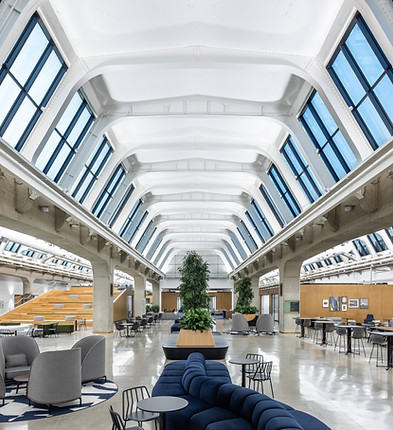

Ford Motor Company
Engineering Laboratory Office Restoration
Constructed in 1924, the impressive sight of Ford Motor Company's FEL building housed the offices of both Henry and Edsel Ford. Over time, the unique features of FEL were covered and abandoned during it's seven year vacancy, and the building’s history all but forgotten.
The entire building was nearly one room and consisted of reinforced concrete columns and ornate concrete brackets supporting steel arches with windows filling the voids between the columns. Those skylights and large windows in the walls ran the entire length of the building, flooding the interior with natural daylight.
Executive offices were housed in a small portion of the building nicknamed Mahogany Row, despite the walls being covered in dark walnut and the floors bright marble.
Bringing history to life



Along with a complete interior finishes and to bring back the architectural presence that started the building’s legacy the skylights were reopened in the center of the original engineering floor space. The result is a 100 foot by 40 foot by 33 foot tall volume of light in a portion of the building now being called The City Center.
This, like the heart of many communities, has become the hub of exciting encounters. In Mahogany Row the marble floors were revealed, the walnut restored, and the toilet rooms transformed back to a 1920’s period washroom. A vehicle research laboratory was added to the project in the addition portion of the building, bringing back one of the original building functions.

Office Renovation






Genesee County Animal Control
Renovations & Additions
Genesee County Animal Control is looking forward to breaking ground on renovating it's aging shelter this spring of 2018.
The new addition will expand the adoptable animal sections and will add a new cat condo area.
Almost Home Animal Shelter
Renovations & Additions
Take a look at the new renovations and improvements coming to Almost Home Animal Shelter. DSD provided architecture and engineering for the renovation.

Oakland County Community Mental Health Authority
Resource & Crisis Center Renovation


More than a face lift
Oakland County Community Mental Health Authority (OCCMHA) commissioned DSD to provide architectural and engineering design services for the conversion of an institutional-style nursing home that was decommissioned years ago into an all-inclusive Resource and Crisis Center.
DSD transformed the 50,000-square-foot building into a pleasant, flowing design utilizing the color themes of the four seasons to create a calming feeling and to delineate spaces from each other.
The design included an expanded centralized lobby created to extend daylight into the facility, public hallways, restrooms, multiple crisis call centers, meeting spaces, a health clinic, a temporary patient holding area, a long-term rehab area, and business services.
the project also included a replacement of mechanical and electrical systems with energy-efficient ones. Repair of existing exterior wall system to bring building’s envelope system in compliance with current building codes.

Wayne County Community College District
Northwest Campus Expansion & Renovation

Innovation in
Energy Efficiency
DSD provided mechanical, electrical, and plumbing engineering services for the new 90,000-square-foot building, for the new Campus Central Heating and Cooling Plant and electrical switch gear located within the new building, and for the
6,000-square-foot addition.
The new flagship building is composed of several offices, including Financial Aid and Academy Advising. New Exercise Labs and locker rooms were built as well as new laboratories and classrooms.
This project integrated a new central heating and cooling plant into the new building and included new primary electrical gear in the GAB addition. The central heating and cooling plant included centrifugal chillers, full ice thermal storage, variable speed pumping systems, geothermal heat pump chiller and a hybrid boiler plant.
WCCCD’s original central heating and cooling plant, built in the 1950s, provided steam and chilled water to the campus through a buried conduit piping system. The central plant building also housed original primary electrical distribution gear. The central plant, conduit piping system and electrical gear had all reached the end of their useful life.



The Larry K. Lewis Education Center was awarded a LEED Platinum certificate by the U.S. Green Building Council. Strategies used within the new building to achieve energy savings, indoor air quality and water use reduction levels included displacement ventilation, passive and active chilled beams, radiant perimeter heating, under floor air distribution, energyrecovery, desiccant dehumidification, solar thermal domestic hot water pre-heat, rain watercapture and reuse, and day lighting controls.
Through use of LED technology fluorescent T5 and T5HO lamps, the design team achieved an overall average power density of .9 watts per square foot.